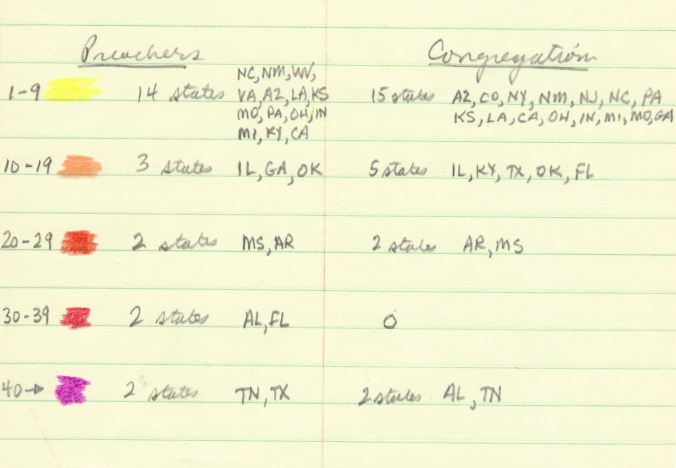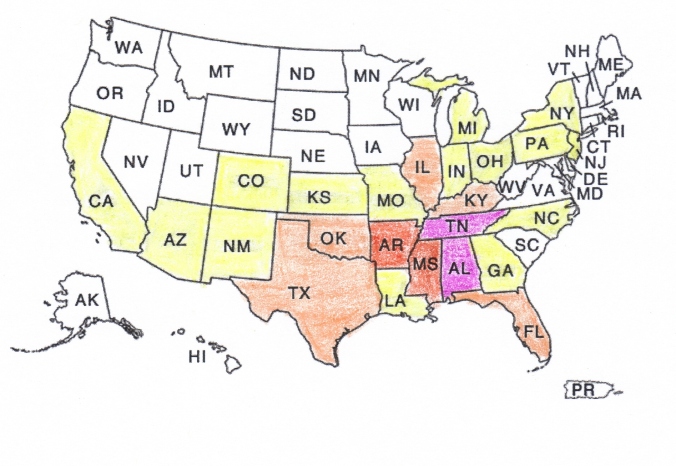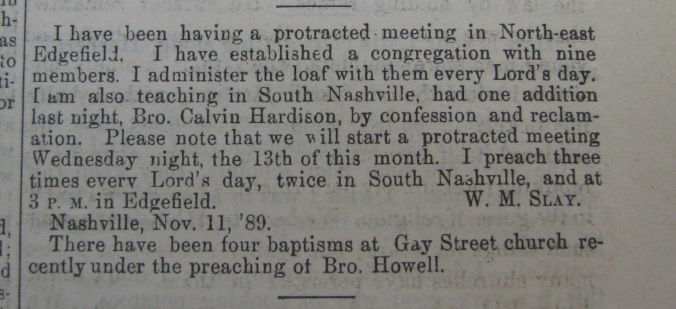In 1942 George Philip Bowser published Directory of the Churches of Christ Colored. A stapled pamphlet of 40 pages, it contains the names of 307 congregations (comprising 17,349 members) and 342 preachers from California to New York and from Michigan to Florida. For each congregation Bowser sought an accurate membership count, the number added during 1942, the value of church property and a contact name. He noted that since some information was lacking, an “approximate record” was given.

Preston Gray, Jr. says this in his Forewords, “We are happy to look out over the vast harvest field of the Lord’s and behold the rapid progress; that is being made among us; although the reapers are few the pace that you have gained thus far is indeed encouraging. Let us, therefore, press on with a greater determination. “FORWARD,” is our motto. Phil 3:13-14.”
As a snapshot of the African-American Churches of Christ at mid-century, it discloses information unavailable elsewhere. There is no indication in this document that it updates or supplements earlier publications. While Leslie Grier Thomas’ New Directory of the Churches of Christ in the United States (Cincinnati: F. L. Rowe, 1939) notes “colored” congregations, it omits many of the congregations on Bowser’s list. Thomas does not list preachers. However Thomas, with George Henry Pryor Showalter, shortly thereafter issued Church Directory and List of Preachers of Churches of Christ (Austin: Firm Foundation Publishing House, 1943). Here appear white preachers and song leaders, “Colored” preachers and song leaders, “Mexican” preachers and “Foreign” preachers and song leaders. In order to identify African-American congregations in this 1943 booklet, it will be necessary to check each entry, something I have not attempted. A similar situation obtains for John P. Fogarty and Olan L. Hicks, 1946-47 Yearbook Churches of Christ (Abilene: Hicks Printing Company, 1947).
Not until Annie C. Tuggle, Our Ministers and Song Leaders of the Church of Christ (Detroit: Annie C. Tuggle, 1945), do some of the names in Bowser’s list find faces and stories through biographical sketches with accompanying photographs. Acknowledging that some did not send in photographs, and thus were omitted, she anticipated their inclusion in a projected second volume. Tuggle lists 134 preachers, 13 song leaders, plus 12 “under age preachers” (among whom is Fred D. Gray) and 3 “under age song leaders.” One will need to search page by page through the various volumes of Preachers of Today and New Testament Churches of Today to locate, where possible…perhaps, additional information beyond what Bowser provides.
Bowser’s list, therefore, appears to be the earliest and most complete of its kind for its time. I spent three evenings working through the lists of congregations and preachers. I do not claim to be a statistician; however, I trust the various data arrangements and charts below will be helpful. Whatever I have done, it is no substitute for reading the actual document. I realize this is no easy task as it is held in only two libraries, Abilene Christian University and Freed-Hardeman University. Should anyone have a copy of this in a personal collection, please consider making it more widely available if only by mailing a photocopy of it to your nearest university or research library.
I welcome additional information, clarification or correction. I should note that I have worked from a copy held in Abilene Christian University’s Center for Restoration Studies, which lacks pages 26-27.
Summary of congregations by state:
15 states (AZ, CO, NY, NM, NJ, NC, PA, KS, LA, CA, OH, IN, MI, MO and GA) have 1-9 congregations each
5 states (IL, KY, TX, OK and FL) have 10-19 congregations each
2 states (AR and MS) have 20-29 congregations each
No state has between 30-39 congregations
2 states (AL and TN) have above 40 congregations each
Number of congregations by state:
1 each: Arizona, Colorado and New York
2 each: New Mexico, New Jersey and North Carolina
3: Pennsylvania
4 each: Kansas and Louisiana
5: California
6: Ohio
7 each: Indiana and Michigan
8: Missouri
9: Georgia
10: Illinois
14: Kentucky
15: Texas
17: Oklahoma
18: Florida
27: Arkansas and Mississippi
46: Alabama
71: Tennessee
Number of congregations by city:
6: Nashville
4 each: Detroit MI and Memphis TN
3 each: Los Angeles CA and Houston TX
2 each: Chicago IL, Indianapolis and Terre Haute IN, Louisville KY, Senatobia MS, Kilgore TX
All other cities have one congregation each
The Nashville congregations are:
Jefferson Street, 500 members, value of church property $4000, R. E. Campbell, 1404 Jefferson
South Hill, 57 members, value of church property $500, Joe Dewee, 90 Wharf Ave.
Horton Street, 35 members, value of church property $1000, Ollie Anderson, 1300 15th Avenue
Jackson Street, 142 members, value of church property $5000, Robt. Cato, 1912 Morene Street
Green Street, 98 members, value of church property $2500, P. H. Black, 1039 21st Avenue
East Nashville, 6th Street, 84 members, value of church property $2000, Jas. Reese, 618 N. Ninth Street
To present the data in a different form, I color coded two US maps, one according to number of congregations, the other by number of preachers.

Congregations:

Preachers:

Summary of preachers by state:
14 states (NC, NM, WV, VA, AZ, LA, KS, MO, PA, OH, IN, MI, KY and CA) have 1-9 preachers each
3 states (IL, GA and OK) have 10-19 preachers each
2 states (MS and AR) have 20-29 preachers each
2 states (AL and FL) have 30-39 preachers each
2 states (TN and TX) have above 40 preachers each
Number of preachers by state:
1 each: North Carolina, New Mexico and West Virginia
2 each: Virginia and Arizona
4 each: Louisiana and Kansas
5: Missouri
6: Pennsylvania
7 each: Ohio and Indiana
8: Michigan (it may be that Fred Cowan refers to Fred D. Cowin, a white preacher)
9 each: Kentucky and California
10: Illinois
13: Georgia
19: Oklahoma
20: Mississippi
26: Arkansas
30: Alabama
36: Florida
57: Tennessee
63: Texas
Two are unaccounted for inasmuch their address did not list a state. Ten names were duplicated.
Largest congregations:
The top 12 congregations, of 200 or more members each, number 4588 total members:
Valdosta, Georgia: 740
Bradenton, Florida: 586
Atlanta, Georgia: 535
Jefferson Street, Nashville, Tennessee: 500
Muskogee, Oklahoma: 425
Montgomery, Alabama: 400
Oklahoma City: 299
Quitman, Georgia: 287
Cameron, Detroit, Michigan: 213
Chattanooga, Tennessee: 203
Lawton, Oklahoma: 200
Ensley, Alabama: 200
These 17 congregations, from 84 to 178 members each, number 2229 total members:
Tampa, Florida: 178
Thyatira, Mississippi: 176
Lebanon, Tennessee: 175
Okmulgee, Oklahoma: 160
McMinnville, Tennessee: 160
Huntsville, Alabama: 149
Center Point, Arkansas: 147 (listed as Enter Point, which I take to be a typographical error)
Jackson Street, Nashville, Tennessee: 142
Conway, Arkansas: 130
Halls Chapel, Alabama: 120
Statesville, North Carolina: 109
Kileton, Mississippi: 107
Compton, California: 102
Mobile, Alabama, 100
Oak Grove, Tennessee: 98 (in West Tennessee?)
Murfreesboro, Tennessee: 92
East Nashville, Tennessee: 84
Number of congregations, members and preachers alphabetically by state:
| State |
Congregations |
Members |
Preachers |
| Alabama |
46 |
2587 |
30 |
| Arizona |
1 |
50 |
2 |
| Arkansas |
27 |
1100 |
26 |
| California |
5 |
269 |
9 |
| Colorado |
1 |
22 |
0 |
| Florida |
18 |
1509 |
36 |
| Georgia |
9 |
1755 |
13 |
| Illinois |
10 |
234 |
10 |
| Indiana |
7 |
227 |
7 |
| Kansas |
4 |
142 |
4 |
| Kentucky |
14 |
360 |
9 |
| Louisiana |
4 |
186 |
4 |
| Michigan |
7 |
400 |
8 |
| Mississippi |
27 |
878 |
20 |
| Missouri |
8 |
220 |
5 |
| New Mexico |
2 |
42 |
1 |
| New Jersey |
2 |
55 |
0 |
| New York |
1 |
40 |
0 |
| North Carolina |
2 |
115 |
1 |
| Ohio |
6 |
153 |
7 |
| Oklahoma |
17 |
1500 |
19 |
| Pennsylvania |
3 |
161 |
6 |
| Tennessee |
71 |
4358 |
57 |
| Texas |
15 |
986 |
63 |
| Virginia |
0 |
0 |
2 |
| West Virginia |
0 |
0 |
1 |
| Unknown |
* |
* |
2 |
|
|
|
|








